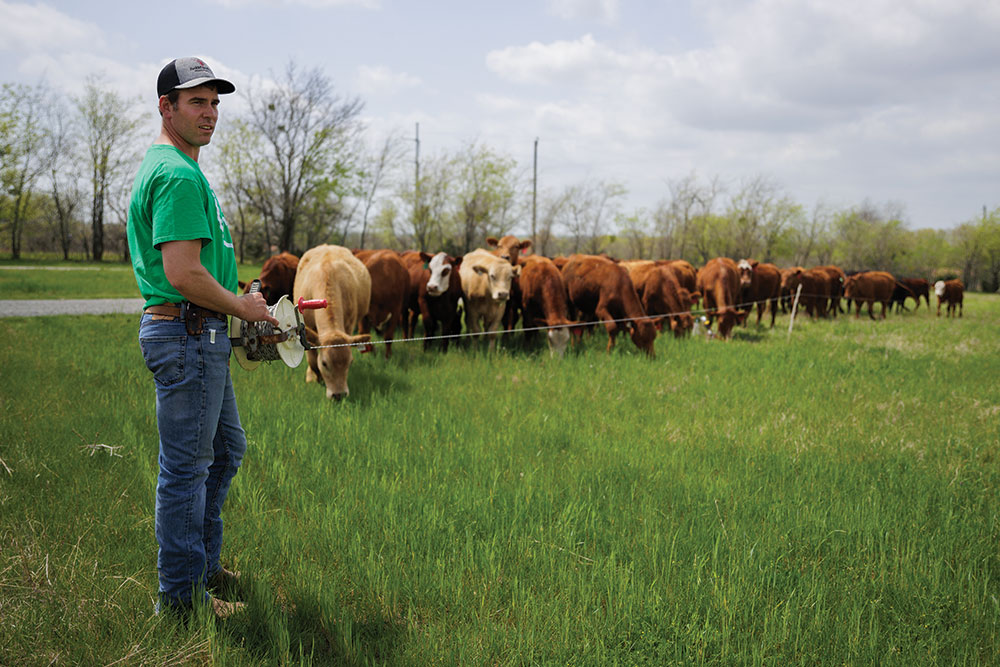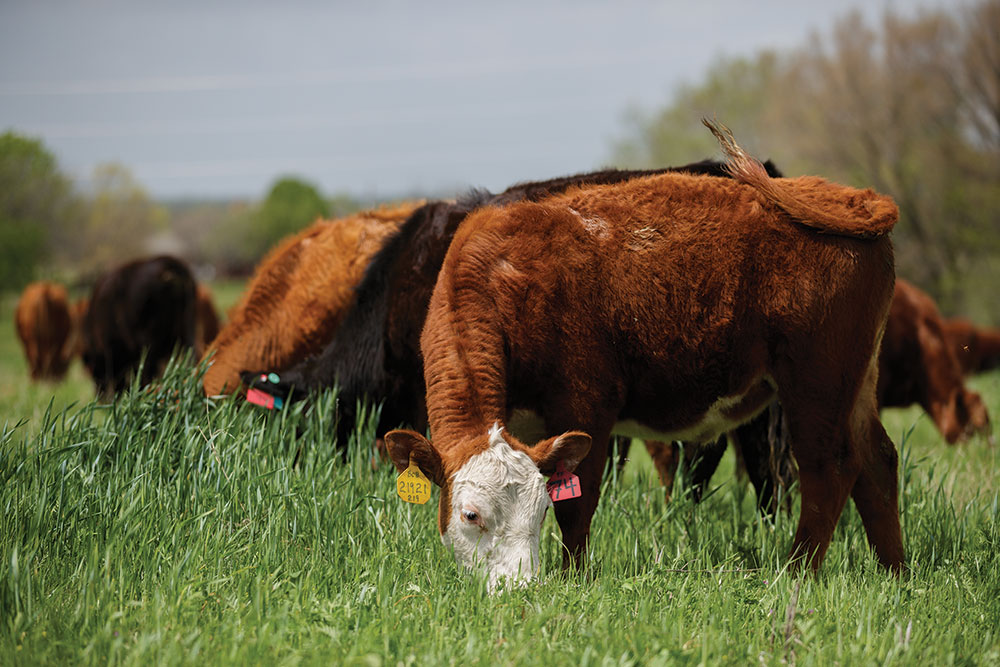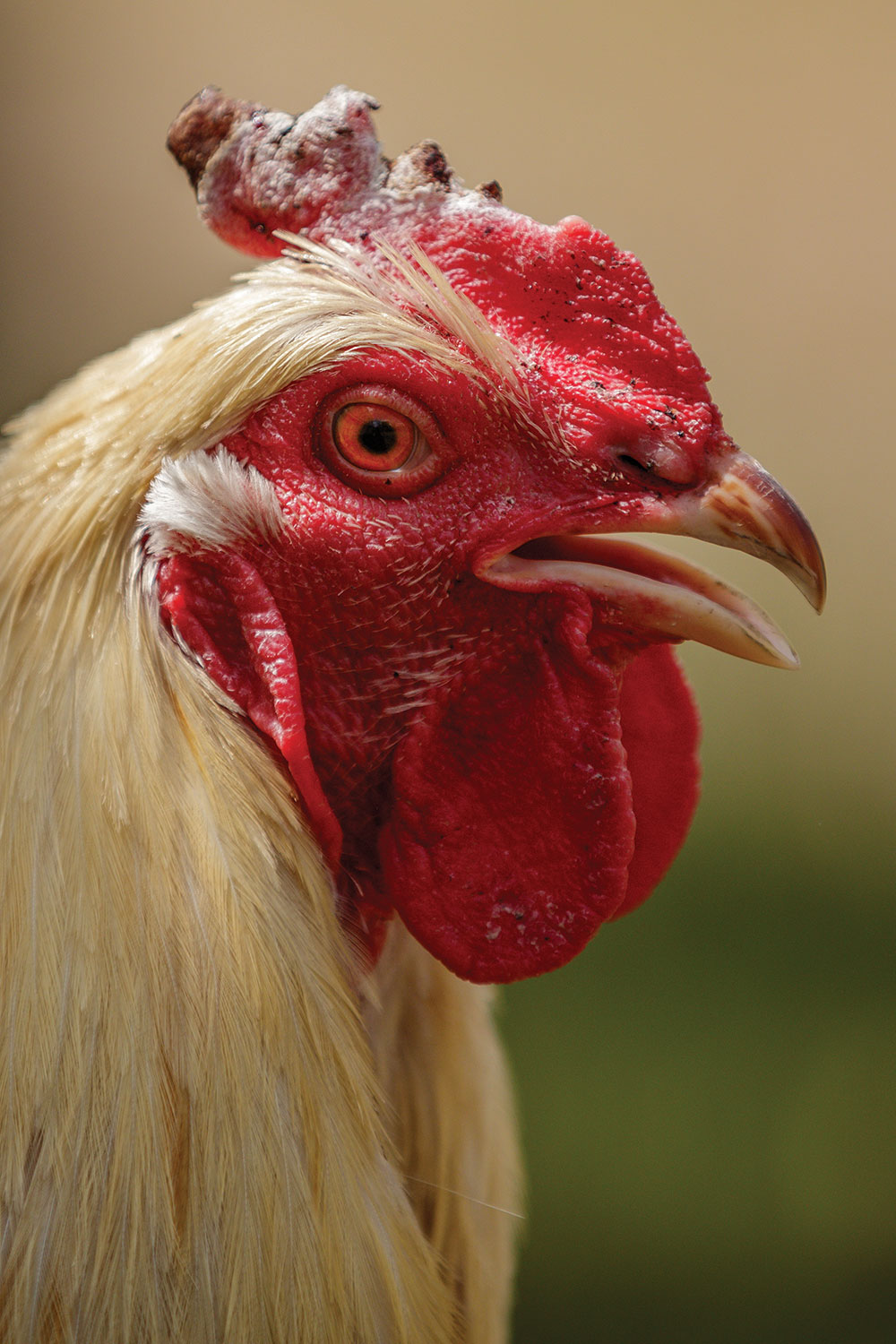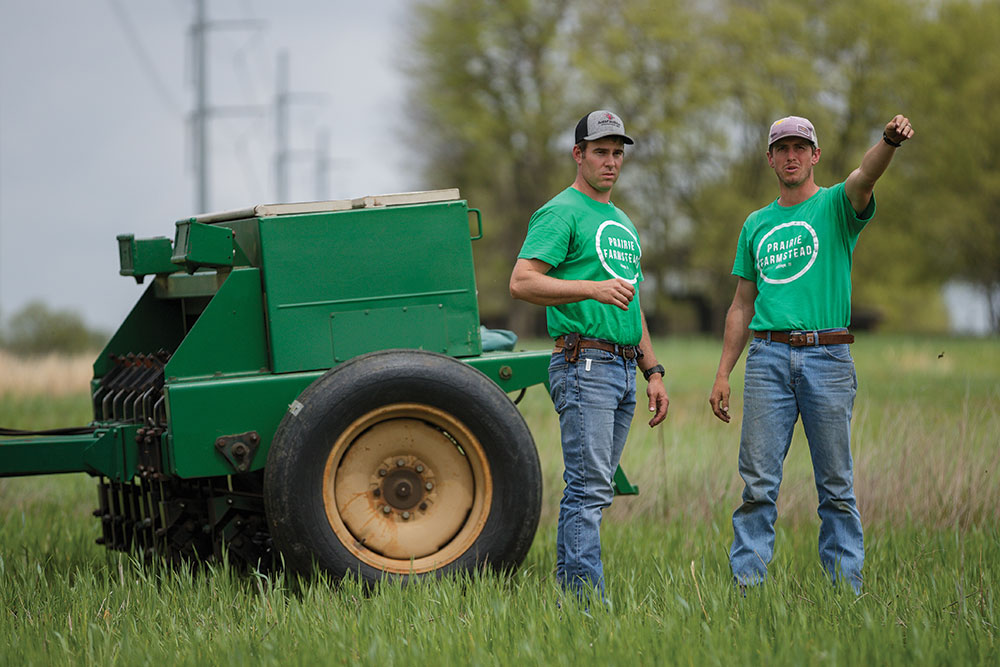A gathering of red and tan cattle stands in a pasture in front of Chuck Trowbridge’s house.
They look up from their grazing as he unrolls a strand of electric fence parallel to the one they stand behind. With the new, half-acre paddock secure, the cattle flood into a fresh buffet of green oats, wheat, crimson clover, vetch and ryegrass. It is their second move of the day, with another yet to come.

Beyond a children’s playset behind the Trowbridge home, Weiwu, the Chinese guard goose, waddles alongside a flock of red laying hens. They scratch the ground previously grazed by the cattle, helping the soil break down organic matter and leaving behind additional nitrogen. A mobile high-tunnel structure offers the birds respite against the sun and wind and provides a mechanism for collecting eggs.

Deeper into the woods, a herd of hogs relaxes in the cool shade of pecan and oak trees. Some loll about in the mud. Others root in the underbrush, pulling up vines and sniffing out fallen nuts. Gradually, the hogs are clearing out small trees and opening up the forest floor to grow more cattle-supporting grasses.
While beef cattle may be the pinnacle of the historically blackland prairie where bison once roamed, every animal has its place here on Prairie Farmstead in Sherman, Texas. Chuck and his wife, Molly, started the regenerative farm with her parents, Steve and Carnelia Blazo, in 2017.
Each animal adds another layer of nutrition and impact to the soil, making it richer when combined with diverse forages and rested pastures. They also add dollars to each acre with beef, pork and eggs.
The regenerative approach is far from the way Trowbridge was raised. However, it has created a profitable path for him to return to production agriculture and build the life he wants for himself and his family.
From Dairy to Prairie
Trowbridge grew up on 650 acres of cropland, pasture and timber in southwestern New York, near the Pennsylvania border.
Like many of their neighbors, the Trowbridges operated a dairy. They sold the dairy herd when Chuck was a young boy but continued to support the industry with their small feed mill. They ground farmers’ grain into custom livestock feed blends.
Trowbridge also milked cows for a neighbor after school during his teen years and drove a combine during the fall harvest. In the summers, he made lots of hay.
Beef cows replaced dairy in the family’s pastures. They sold freezer beef as well as pork raised in a small barn on their property to neighbors. Management of the cattle was mostly hands-off. They fed hay more than half the year and plenty of grain supplement year-round. The idea of moving cattle seemed like a waste of time. Only one neighbor used rotational grazing management, and no one understood why.
Regenerative agriculture is a slow ball to start rolling. But when that ball does start rolling, it really takes off.”
Chuck Trowbridge
After high school, Trowbridge moved to Longview, Texas, to study engineering at LeTourneau University. He met his wife there and followed her to the Milwaukee, Wisconsin, area when she was accepted to graduate school.
Trowbridge wanted to farm again with his dad. He especially wanted to improve their beef operation. So, the couple decided they would move back to New York as soon as Molly graduated. Before they could, however, the elder Trowbridge died and so did Chuck’s opportunity and desire to return to the family land.
The farm boy had trouble adjusting to apartment-living in the city, though. A 40-hour week in a cubicle job left him “absolutely bored.” So, he met grain farmers in the area and volunteered to drive a tractor for them on weekends. He also started reading books about agriculture, trying to find a way to farm without his dad.

Chuck and Molly also connected with the farm-to-table movement booming in southeastern Wisconsin at the time. They ate in restaurants featuring locally grown ingredients and met with the farmers who supplied them. Trowbridge discovered organic and grass-based farming and learned how different people were creating alternative markets in agriculture.
He realized that by serving a niche market of people looking for proteins raised on pasture, it was possible to start a farm from scratch without inheriting land. Going direct-to-consumer would allow him to start small and grow from there. The key would be stacking enterprises or diversifying production so that multiple products could come from one piece of land.
When Molly finished her training in 2014, the couple moved to Texas to be closer to her family. They began watching for available land in the area, and, two years later, found the Sherman property, moving there in 2017.
3 tips for raising grass-finished beef
When Chuck Trowbridge started raising beef to sell directly to consumers, he leaned into what he had read and the advice of mentor farmers:
- Don’t start by building a cow-calf herd. Instead, buy stockers first and learn to finish an animal on grass so that it tastes good.
- Buy calves born into an operation like your own, ready to thrive on grass alone.
- Market early. Finding calves that met his specifications (no antibiotics, no wormer, no fly control, and no grain or grain byproducts) proved more difficult than Trowbridge imagined. He finally found a group of Angus steers from a ranch in Sulphur Springs, Texas, and has started a network of producers to help each other find the cattle they need for their systems. It’s a model he also applies to his pork enterprise.
Underground Livestock
Trowbridge decided to develop a grass-based system that would support beef cattle, chickens and eventually pigs, which were added in 2021. He chose to forego herbicides and insecticides and to minimize use of synthetic fertilizer. His plan, instead, was to build up the land’s natural ability to grow nutritionally dense food and increase water infiltration, both of which his research had told him depended on soil health.
Soil tests confirmed he did not have much organic matter in his soil at first. The land had previously been used primarily for hay. Monoculture johnson-grass was sprayed every couple of years for broadleaf weeds, but otherwise received little attention and no grazing. Only a few, sporadic spots of ryegrass grew as winter forage.
At the recommendation of Noble Research Institute, Trowbridge started planting diverse winter cover-crop mixes to increase forage production and soil health. He rented a no-till drill for the first plantings, then he and a friend purchased one off Craigslist. Recently, he began experimental plots of summer cover crops.

Abundant, diverse roots benefit the fungi and other microbes in the soil, which Trowbridge describes as the underground livestock that drive forage production for his above-ground livestock. While the cover crops have been helpful, Trowbridge says his best tools have been the cattle themselves, as well as the chickens.
His cattle move across pastures one small area at a time, typically at least once per day. The chickens also move daily. He follows a yearly plan to graze cattle across the entire farm over the course of the growing season, giving pastures time to rest before they are grazed again. He takes note of rainfall and forage growth and adjusts as needed to prevent overgrazing.


Trowbridge is building a perennial polyculture that eventually will not require annual cover-crop plantings. Getting there will take time, he says, but he knows he’s going in the right direction. He has seen native grasses, including bluestems, return and, in the past two years, more production overall.
More forage not only supports more cattle, it shields the soil from the sun. More earthworms have also returned to carve holes into the earth and improve soil structure. Trowbridge can now drive his ATV across a pasture after a rain without leaving deep ruts.
Most excitingly, he says, he found his first dung beetle a couple of years ago. He describes them as nature’s way of digesting and burying manure into the soil so that plants can access nutrients more quickly.
“Regenerative agriculture is a slow ball to start rolling,” Trowbridge says. “But when that ball does start rolling, it really takes off.”

Farm To Plate
Trowbridge always wanted to feed people: his family first, including his three children, ages 6, 4 and 1, then, as he could, others in the area.
In his first year, Trowbridge planned to market five steers. He used word of mouth and social media to tell his story. All five steers were sold long before they were finished. They soon added eggs and more cattle for more beef. Last year, they started selling at a farmers market. Talk keeps spreading, and now they supply eggs to a local store and a restaurant.
Most recently, they purchased a website service called Eat From Farms. It allows people to shop online for Prairie Farmstead’s beef, eggs and pork, as well as chicken raised by like-minded producers. Purchases can be picked up at the farm, designated drop-off locations or the farmers market.
“I’m not a marketing or social media person at all, but there are tools out there that can help with that,” Trowbridge says. “Pay for the tools that will work for you.”

Flavor First
A soon-to-open butchery-restaurant combo plans to source beef, pork and eggs from Prairie Farmstead. Heritage Butchery & Barbecue (www.heritagebutchery.com) wants to give customers a next-level farm-to-table experience at its Denison, Texas, location. The full-carcass butcher shop will offer custom cuts and meals featuring slow-smoked Texas barbecue and cooked-to-order hamburgers.

“I see cows on bare pastures, while Chuck’s got tall grass,” says Pete Gonzales, the visionary behind Heritage Butchery & Barbecue. Gonzales grew up in rural communities and wants to see farmers be more profitable. “I see he really cares about the earth and the animals. It speaks to our hearts.”
His product also tastes good, says Brad Hammett, a funder for the new business. He has bought grass-finished beef elsewhere, and says Trowbridge’s is “hands-down” better. It does not have the stereotypical aftertaste often attributed to grass-finished beef.
What an animal eats in its final 30 days affects the flavor profile of the beef, Trowbridge says. Prairie Farmstead harvests only during seasons with abundant forage, meaning it does not generally make beef available year-round. However, they hope to extend the harvest season to supply Heritage’s needs by purchasing both fall and spring calves and feeding some through an extra winter.
I see cows on bare pastures, while Chuck’s got tall grass. I see he really cares about the earth and the animals.”
Pete Gonzales
A common mistake people make when raising grass-finished beef is harvesting by age rather than animal finish, says Trowbridge. Cattle will be ready at different times, he adds, largely based on genetics and on average daily gain, which varies year to year in a grass-based system.
He weighs the calves at least twice per year and keeps a running list of the order in which he thinks each one will finish. Then he watches how they fatten up. A calf is ready to go when multiple rolls of fat on either side of its tail head jiggle when it walks, as well as when the brisket fills out the neck skin, he says.
It currently takes Trowbridge 24 to 30 months to finish a steer on his forage base, but he anticipates this timeline will shorten as soil health and forage production improve.
Soon, he’ll send his third batch of hogs to market after seven to eight months under the trees. The group of 12 came to the farm at eight weeks of age and was trained to the electric fence. A fourth will follow at the end of the year, and the cycle will continue next year.

Farmers of Tomorrow
Prairie Farmstead now supports two part-time employees who help Trowbridge manage daily operations while he continues his engineering work. As young farmers themselves, they are soaking up everything they can learn from Trowbridge’s journey.
Trowbridge hopes to show young people that agriculture can provide a viable career, especially when focused on improving the soil with help from stacked livestock enterprises and creative marketing.



Comment